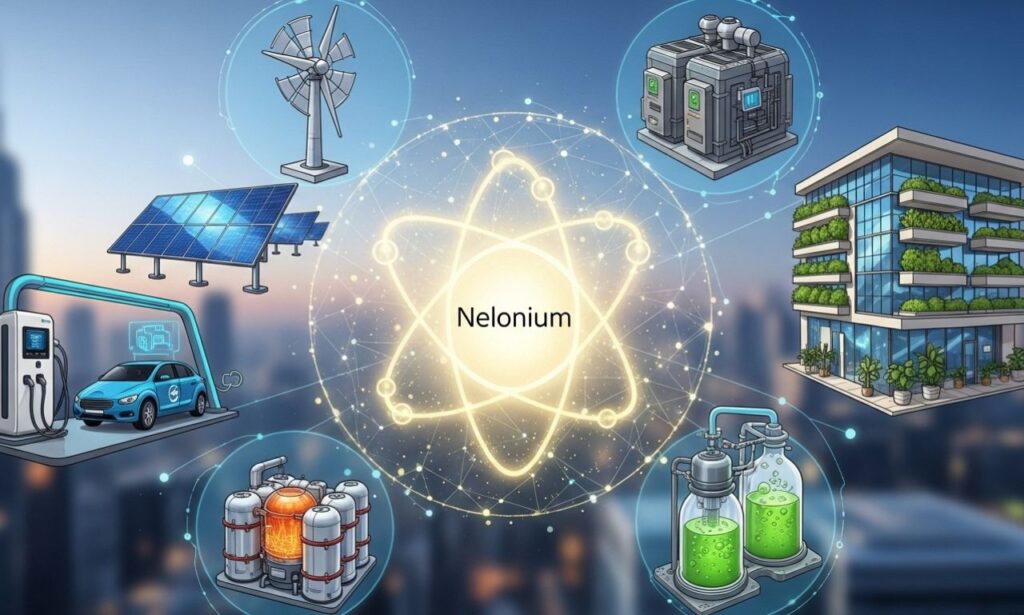In the quest for sustainable technology, innovators are constantly on the lookout for materials that can redefine our approach to environmental challenges. Enter nelonium, a groundbreaking substance that’s making waves across industries. This remarkable material holds the promise of transforming how we harness energy, reduce waste, and create eco-friendly products. But what exactly is nelonium? And why should we care about it in today’s world? Dive into this exploration of nelonium’s unique properties and its pivotal role in shaping a more sustainable future.
What is Nelonium?
Nelonium is an innovative material that has captured the attention of researchers and industry pioneers alike. This unique compound boasts a remarkable blend of properties that make it suitable for various applications in sustainable technology.
At its core, nelonium exhibits exceptional durability while remaining lightweight. These characteristics enable it to perform exceptionally well under challenging conditions, which is crucial for modern advancements in technology.
Moreover, nelonium is derived from sustainable sources, aligning perfectly with eco-friendly initiatives. Its production process minimizes environmental impact compared to traditional materials.
Scientists are continually exploring its potential benefits across numerous sectors—from renewable energy systems to advanced consumer electronics—further solidifying its place as a game-changer in the realm of sustainability.
The current state of sustainable technology
Sustainable technology is at a pivotal moment. As global awareness of environmental issues rises, the demand for innovative solutions grows. Companies and researchers are pushing boundaries to create eco-friendly alternatives.
Solar panels and wind turbines have become household names, powering homes with renewable energy. Electric vehicles are gaining traction as cities invest in charging infrastructure.
However, challenges remain evident. Many traditional materials still dominate production processes, hindering progress. There’s also a pressing need for lower-cost options that don’t compromise quality.
The integration of sustainable practices into industries like construction, agriculture, and manufacturing is essential. This shift requires collaboration among stakeholders—governments, businesses, and consumers alike—to foster innovation.
Emerging technologies like Nelonium present exciting opportunities to bridge gaps within sustainable tech sectors while addressing these challenges head-on.
How Nelonium is revolutionizing sustainable technology
Nelonium is transforming the landscape of sustainable technology. Its unique properties enable innovations that were previously unimaginable.
This advanced material exhibits remarkable durability while being lightweight. Such characteristics make it ideal for applications in renewable energy solutions, like solar panels and wind turbines.
Furthermore, Nelonium’s ability to be recycled enhances its appeal in a world increasingly focused on reducing waste. Industries are now exploring ways to integrate this material into everyday products without compromising quality or performance.
The potential for Nelonium extends beyond just energy production. It holds promise in sectors such as construction, where eco-friendly materials are crucial for reducing carbon footprints.
As research expands, new methods of harnessing Nelonium’s capabilities emerge regularly. This evolution could lead us toward a future where sustainability is not just an option but an integral part of technological advancement.
Applications of Nelonium in various industries
Nelonium is making waves across multiple industries, showcasing its versatility and efficiency. In the renewable energy sector, it enhances solar panels’ performance. Its lightweight nature makes installations easier while improving energy absorption.
In construction, Nelonium is being used to create sustainable building materials. This innovation reduces carbon footprints significantly compared to traditional options.
The automotive industry also benefits from Nelonium’s properties. It contributes to lighter vehicle designs without compromising safety or durability, leading to improved fuel efficiency.
Electronics manufacturers are exploring Nelonium for its excellent conductivity and thermal stability. These attributes make it an ideal candidate for advanced circuit boards and components.
Healthcare applications are promising as well; Nelonium’s biocompatibility opens doors for use in medical devices and implants. Each of these sectors illustrates how integral Nelonium could become in creating a more sustainable future.
Advantages of using Nelonium over traditional materials
Nelonium offers several advantages that set it apart from traditional materials. Its lightweight nature makes it an excellent choice for applications where weight reduction is critical, such as in aerospace and automotive industries.
Durability is another key feature. Nelonium resists wear and corrosion far better than many conventional alternatives, ensuring longer lifespans for products made from this innovative material.
Additionally, its flexibility allows for innovative designs that can adapt to a variety of uses. This adaptability opens the door to new engineering possibilities that were previously unattainable.
Environmental impact matters too. Nelonium can be produced using less energy compared to traditional materials, reducing carbon footprints during production processes.
Cost efficiency plays a significant role. While initial investments may vary, the long-term savings due to lower maintenance and replacement costs make Nelonium a wise financial choice over time.
Challenges and limitations of Nelonium
While Nelonium presents exciting possibilities, it is not without its challenges. One significant hurdle is the cost of production. Manufacturing Nelonium can be more expensive than traditional materials, making it less accessible for some industries.
Additionally, there are technical limitations to consider. The material’s properties may not always meet the specific requirements of every application. This limits its versatility in certain contexts.
Some environmental concerns also surround Nelonium’s lifecycle. Although it’s designed with sustainability in mind, questions about biodegradability and long-term impact remain.
Furthermore, widespread adoption requires extensive research and development. Industries must invest time and resources to integrate Nelonium effectively into existing systems.
Regulatory hurdles can slow down innovation. Companies must navigate complex guidelines before they can bring new products utilizing Nelonium to market.
Future prospects and potential advancements in Nelonium technology
The future of Nelonium technology is brimming with potential. Researchers are exploring innovative methods to enhance its properties, making it even more effective for sustainable applications.
One exciting area of advancement is the integration of Nelonium in energy storage solutions. By improving battery efficiency and lifespan, it could significantly reduce our reliance on traditional materials.
Moreover, advancements in manufacturing techniques may lead to lower production costs. This accessibility would encourage wider adoption across various industries.
There’s also a growing interest in combining Nelonium with other eco-friendly materials. This synergy could unlock new functionalities tailored for specific environmental needs.
As awareness around sustainability increases, investments in Nelonium research will likely grow. Collaboration between academia and industry can drive breakthroughs that transform how we approach technology sustainably.
The importance of adopting sustainable solutions like Nelonium in today’s world
As the climate crisis intensifies, the urgency for sustainable solutions has never been more critical. Traditional materials often come with hefty environmental costs. This is where Nelonium shines.
Embracing innovations like Nelonium paves the way for a greener future. It offers an eco-friendly alternative that minimizes waste and reduces carbon footprints in various industries.
By prioritizing sustainable options, businesses can not only adhere to regulatory demands but also cater to a growing consumer base that values responsibility over convenience.
The transition to materials like Nelonium isn’t just about compliance; it’s about creating a legacy of stewardship for upcoming generations. The time to act is now, and every step toward sustainability counts significantly in this global effort.
Conclusion
The role of nelonium in sustainable technology is becoming increasingly vital. As industries seek alternatives to traditional materials, the unique properties of present exciting opportunities. This innovative material not only enhances efficiency but also minimizes environmental impact.
Adopting solutions like nelonium can significantly influence our approach to sustainability. By prioritizing such advancements, we can pave the way for a greener future and foster a culture that values eco-friendly innovations.
As developments continue, it will be intriguing to see how far nelonium can take us in achieving global sustainability goals. The potential applications are vast and could transform numerous sectors for the betterment of our planet. Embracing materials like isn’t just an option; it’s an imperative step toward a more sustainable world.






